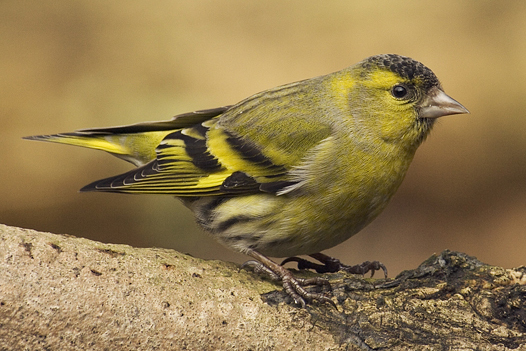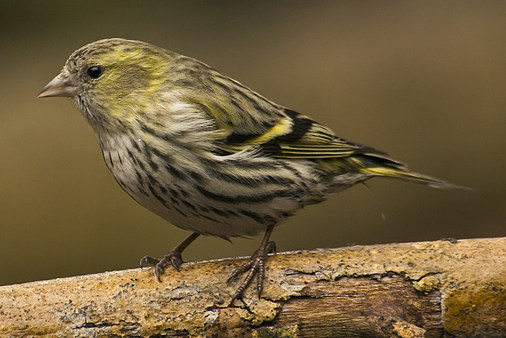Garden Wildlife
Garden Wildlife


Siskin Spinus spinus
Siskins are attractive small finches favouring coniferous woodland and are recorded in about 5% of gardens. They were originally found mainly in the Scottish Highlands and Ireland but are now breeding in more lowland wooded sites, and in Wales and some other more forested areas of England. They have discovered gardens and the benefit of feeders to keep them going in winter.
What do they look like?
Siskins are like small greenfinches. Males are greenish-yellow, with bright yellow bands on the wing and behind the eye. The top of the head and chin are black. Females are greyer and have a lighter head but with much more striped under parts. Siskins have a relatively short beak suited for extracting seeds.
What do they sound like?
Their song is a prolonged twittering, with a high pitched “te-seep” call
Song Call
What do they eat?
Siskins specialise on eating tree seeds of conifers, alder and birch, but will take insects and spiders in summer. They like sunflower hearts and nyger seed from feeders
Where do they breed?
Siskins breed in large areas of coniferous woodland and are not much seen outside them in the breeding season of April to August. They have two broods of up to 5 eggs each year
What do they do?
Siskin are rarely seen in gardens in the summer, but are much more often seen in winter when they will come to feeders in gardens all over Britain and Ireland. In good years with plenty of natural food they are less common in gardens, getting what they need in their more typical coniferous woodland habitat.
How are they doing?
Siskin are green listed, but their population seems to swing up and down over the years and is currently in a bit of a decline. There are estimated to have been about 445,000 breeding pairs in 2016.
Finding out more:
BTO profile on siskin
RSPB profile on siskin
Page written and compiled by Steve Head


Lars Edenius, XC702709. Accessible at www.xeno-canto.org/702709
Lars Edenius, XC703787. Accessible at www.xeno-canto.org/703787.
What do they eat?
Siskins specialise on eating tree seeds of conifers, alder and birch, but will take insects and spiders in summer. They like sunflower hearts and nyger seed from feeders
Where do they breed?
Siskins breed in large areas of coniferous woodland and are not much seen outside them in the breeding season of April to August. They have two broods of up to 5 eggs each year
What do they do?
Siskin are rarely seen in gardens in the summer, but are much more often seen in winter when they will come to feeders in gardens all over Britain and Ireland. In good years with plenty of natural food they are less common in gardens, getting what they need in their more typical coniferous woodland habitat.
How are they doing?
Siskin are green listed, but their population seems to swing up and down over the years and is currently in a bit of a decline. There are estimated to have been about 445,000 breeding pairs in 2016.
Finding out more:
Page written and compiled by Steve Head
What do they look like?
Siskins are like small greenfinches. Males are greenish-yellow, with bright yellow bands on the wing and behind the eye. The top of the head and chin are black. Females are greyer and have a lighter head but with much more striped under parts. Siskins have a relatively short beak suited for extracting seeds.
What do they sound like?
Their song is a prolonged twittering, with a high pitched “te-seep” call
Song Call


Siskin Spinus spinus
Siskins are attractive small finches favouring coniferous woodland and are recorded in about 5% of gardens. They were originally found mainly in the Scottish Highlands and Ireland but are now breeding in more lowland wooded sites, and in Wales and some other more forested areas of England. They have discovered gardens and the benefit of feeders to keep them going in winter.
























